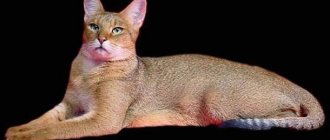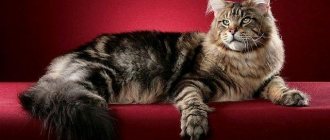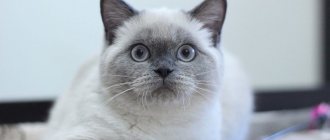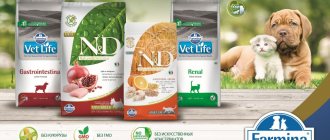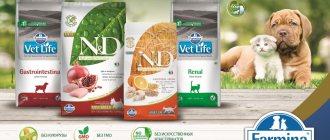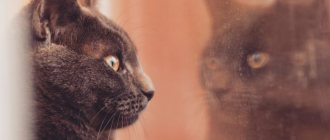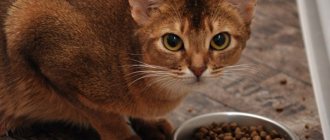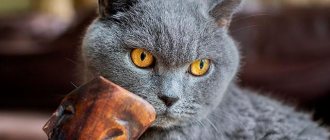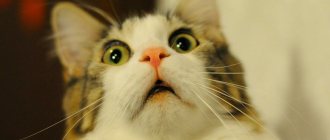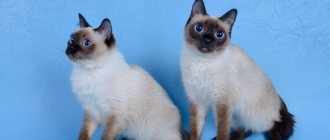Among the many different breeds, the mestizo cat has always been a leader in popularity and prevalence. A mixed breed is a cross between several cat breeds, as a result of which the kitten inherits the best traits of its parents along with its genes. The mixed-breed cat is distinguished by good health, a kind and flexible character, and a beautiful and unusual appearance.
Mixed cat, what does it mean?
Metis is not a cat breed. Such animals appear in a parent couple, where one is a representative of an elite breed, and the second is outbred. Another option is possible - when both parents are elite, but belong to different breeds. Crossing between them is allowed, and the litter acquires the qualities of the parent pair and is able to continue the race.
There is another concept - a cat hybrid. This means that individuals from different branches of the biological tree participated in the crossing. For example, a caracal from the Moscow Zoo mated with an ordinary cat, which subsequently gave birth to a healthy large kitten.
This event became a sensation in world felinology and forced a new look at the process of breeding hybrid cats. Thus, the Chausie breed appeared - a hybrid of the wild jungle cat Felis Chaus and the Abyssinian cat, and the Savannah - a mestizo cat bred by mating an African serval and a bengal.
Participation in exhibitions, documents
This American cat breed was formed many years ago. The task of breeders is to preserve and improve the gene pool. The participation of a simple cat in breeding negates their efforts.
Due to such factors, owners of hybrids cannot exhibit their pets in the breed ring. However, exhibitions where animals of unknown origin are judged are open to them. There they can show the pet and get a description if the cat is healthy, has a beautiful exterior, and an easy-going character. When the kittens grow up, it will become clear how large they will grow and what their show potential will be.
They are allowed into the ring upon reaching 10 months of age. The rules are the same as at regular exhibitions. Separate rings, strict judging. A mongrel pet is prepared with full responsibility: grooming, purchasing accessories. This is a great chance to show your favorite cats to specialists and get a lot of positive emotions from communicating with like-minded people.
Outbred cats are not registered anywhere. They cannot have a pedigree, only a veterinary passport with notes on vaccinations and treatment against worms, which the owner obtains at his own request. Subsequent mating with a coon will still result in his phenotype, and not a true Maine cat.
Advantages and disadvantages of mestizo
According to official data, there are 250 registered cat breeds. The total number of cats living throughout the globe is about half a billion. In addition to officially recognized breeds, there are also stray animals that are not included in the statistics. Random mating results in a huge population of mestizos. Whether this is good or bad is difficult to say, but we have identified several advantages and disadvantages of being mestizos.
Let's start with the pros:
- In the first generation, mixed-breed kittens receive the best characteristics of the parent pair, but later, unfortunately, they lose them.
- Mixed breeds are often healthy, but if one or both parents have an altered genotype, the kittens are more likely to be born sick.
- By purposefully crossing several breeds, it is possible to obtain an animal with a certain set of external qualities.
- The character also determines the genotype of the parental pair. A pampered Persian cat and a calm mongrel cat will not produce aggressive kittens.
As for the disadvantages, there are few of them - keeping a mestizo in the house is neither prestigious nor profitable.
Half-breeds do not have the right to participate in exhibitions, do not have a pedigree, are not allowed to crossbreed with elite animals, and there is no queue of people who want to get a purebred pet. However, cat lovers in most cases do not pay attention to such nuances and happily take outbred animals from the shelter.
How to choose?
Mixed-breed cats are sold everywhere. In order not to make a mistake when choosing a pet, it is useful to familiarize yourself with the following recommendations:
- Look at the mother, ask what cats were crossed with.
- Ask about the character of the parents, the presence of any special features.
- Ask about preventive vaccination and whether you have been examined by a veterinarian.
- It is better not to adopt obstinate kittens. If they scratch and hiss from childhood, there is a high probability that at an older age the individuals will be aggressive and unyielding.
When choosing a small pet, you need it to look healthy in appearance.
In addition to recommendations, it is worth paying attention to the appearance of the animal. If the cat has no health problems, he will have clean, shiny and smooth fur, clear eyes, an energetic character and curiosity. It is important to look at the belly; it should not be swollen, otherwise there is a risk of the kitten becoming infected with parasites or developing intestinal diseases.
Metis with British
The British cat is an indigenous breed with an ancient history of development, which begins in the days of the Roman legionnaires. These animals are endowed with refined manners, prefer solitude, do not like noisy companies and too active games. The most common crosses of British cats are with ordinary cats, with Toygers and with Siamese.
A mix of a British cat and a regular cat
Outbred cats have an amazing ability to quickly adapt to their environment. These animals are independent, unpretentious, endowed with excellent hunting skills that allow them not to die of hunger, which cannot be said about most purebred domestic cats.
It is worth noting that street cats do not strive for privacy; they are sociable and do not mind contact with people if they behave kindly. Animals that are brought into the home at an early age are socialized no worse than purebred cats.
Mixed breeds of a British cat and a regular one are most common. Sometimes at first glance it is even difficult to distinguish who is who. Half-breeds have the same massive bone structure and broad chest, but are slightly smaller in size. Developed cheeks make the muzzle round.
Coat colors are varied. The British are characterized by about 200 colors, so the color options for mixed breeds are unlimited. There are individuals with a color-point mask like the Siamese or spectacular silver chinchilla ticking.
The Métis partly adopt the British desire for privacy. Such animals are more eager to be the center of attention; they are quite sociable and responsive.
Interesting. At an early age, half-breeds exhibit to a greater extent the manners of mongrel animals, and in adulthood they show prudence and sedateness - qualities inherent in the British breed.
Toyger/British mix
Mixed Toyger + British cat is an animal with a clear striped pattern on its fur. The Toyger breed was developed relatively recently and received admission to the exhibition career in 2007. These cats are characterized by the only so-called brindle color.
Toygers are much thinner than the British, have an elongated body and long legs. Mestizos are distinguished by an average constitution, proportional physique, and a beautiful fur coat with a tabba pattern. The bands may be clear or blurred, but are present in 95% of cases.
The character of half-breeds is more reminiscent of the British. They are just as prim and calm. Second-generation mestizos resemble only one of their parents.
Mix of Siamese and British cat
Mixed breeds of British and Siamese cats are spectacular beauties with a solid color, for which the C gene is responsible, which is involved in the formation of the color point color.
The Siamese color depends on the animal's body temperature. The body of cats is warmer, so the gene does not appear in this part of the body. The fur on the body is always light. The limbs, ears, muzzle and tail are cooler, so the coat is darker in these areas. The British are also characterized by the Siamese color, which is inherited.
A cross between a Siamese and a Briton looks heavy, has a massive bone structure and a wide chest, long legs and a tail.
Kittens inherit an independent character and egocentrism (from the British), resentment and rancor (from the Siamese). The British genotype is considered dominant, which is often expressed in complete resemblance to the aristocratic breed.
Maine Coon mixes
The Maine Coon is a large-sized native cat breed. The animals are distinguished by their massive build, strong bones, angular contoured muzzle, and large ears with tufts. Colors can be any: cinnamon, lilac, chocolate and fawn, solid.
The coat is thick, water-repellent, and the undercoat is soft. The neck is decorated with a frill. The tail is long, wide at the base, tapering to the tip, covered with long hair. The eyes are oval, expressive, the color of the iris matches the color of the coat.
Breeding Maine Coon mestizos is officially prohibited, but in reality this issue is not controlled. Amateur breeders often breed Maine Coons with other cat breeds. Half-breeds are much cheaper, which increases the demand for them.
In specialized nurseries, cull cats are not sold for breeding, but they can be purchased as a pet. Such animals must be castrated or sterilized.
It is also important to remember that a purebred Maine Coon and a mixed breed are completely different animals. A half-breed will never meet the breed standard. The appearance of such cats is very diverse and depends on the genotype of the parents.
Purebred Maine Coons are endowed with the following qualities:
- goodwill;
- agreeableness;
- sociability;
- devotion;
- prudence.
When crossed with a regular cat, these traits change or disappear completely.
As for external qualities, purebreds must have tufted ears, an elongated muzzle, massive paws, and a long fluffy tail. Three-month-old kittens should weigh at least 2.5 kg (the cubs of an ordinary cat at this age weigh no more than 1 kg). The body length of adult males is approximately 1 m and weight is 11 kg.
As for attempts to crossbreed the Maine Coon with other breeds, they all failed. The purpose of such experiments was the desire to add some qualities from other breeds to Maine Coons. For example, to produce a big cat of an unusual color, a female Maine Coon was bred with a male Siamese breed. However, the experiment was unsuccessful - kittens of different sizes were born in the litter.
When mated with Persians, the result was large kittens with fluffy red fur without the slightest hint of resemblance to Maine Coons. An attempt to crossbreed with a Bengal to increase body size also failed.
Maine Coon and Siberian kittens are similar in appearance to purebreds, but are of medium size. Such babies are often passed off as noble, but they are sold at a discount and without a pedigree.
A mixed breed of a Maine Coon and a domestic cat was obtained completely by accident. The baby retained the color of his coat, but lost a number of positive character traits.
Maine Coons are also crossed with Britons, Neva Masquerade and other breeds of cats, producing litters with fur of different lengths.
Possible offspring
No significant changes are expected in terms of coat color. Most domestic cats without admixture from other breeds have the colors acceptable in Maine Coon Cats. But genetics suggests unexpected results. Mutations, such as polydactyly, which is common in coons, are likely to affect part of the litter. Coat color and pattern are inherited according to established laws.
Science knows interesting facts about eye color. Usually it does not depend on the color of the coat, but blue pigment accompanies color-point colors (Siamese cats), and less often white. In practice, if you cross a green-eyed coon with a blue-eyed female, the offspring will most likely take after the father for this trait. This happens because green is dominant to blue. When white kittens are born, the situation may change.
All Maine Coon cats have medium-length fur. If you cross a representative with a smooth cat, the litter will be short-haired. The birth of kittens with long hair is possible if there are two long-haired parents.
Character and behavior are unpredictable in this combination. Street cats are more aggressive by nature, this is dictated by the laws of survival in difficult conditions. Pedigree cats are softer, because purposeful work has been carried out for decades to consolidate behavior that is comfortable for humans.
Weight and body structure are also difficult to calculate, but most half-breeds are distinguished by their impressive dimensions, although they are inferior to their purebred parents. Kittens are born with different characteristics, some are smaller, some are larger.
Metis requires the same careful attention as a purebred animal. A balanced diet, walks, and the love of the owner are mandatory criteria for the happiness of any pet.
Mixed bengal cat
The Bengal cat is a cross between a domestic cat and an Asian leopard. Mating Bengals with other breeds is prohibited by all felinological organizations. There are no recognized crossbreeds of this breed, but this does not prevent unscrupulous breeders from crossing Bengals with other breeds or ordinary cats. As a result, mestizos with a variety of colors appear. The second generation completely loses the characteristics of its parents.
Recently, long-haired Bengals have become especially popular; they retain the characteristics of the breed, but have long hair, a fluffy collar and tail.
If earlier breeders sterilized such animals, now the long-haired variety is valued higher than the traditional Bengal cat.
Why is hybrid breeding problematic?
Crossing domestic cats with wild cats is a controversial issue. Many animal rights activists are of the opinion that this process is harmful to animals because the individuals being mated are significantly different from each other and mating should not be allowed for ethical, genetic and medical reasons.
This fear is not unfounded, since there are indeed many miscarriages and birth defects, especially in first-generation kittens. The reason for this is probably because the length of pregnancy varies greatly between domestic and wild cats. In domestic cats, pregnancy usually lasts from 63 to 65 days, while in wild cats it usually lasts from 76 to 78 days. Not only pregnancy itself is dangerous, but also mating animals.
Persian cat mixes
The Persian cat is one of the most popular breeds in the world. The variability of colors is amazing; in this regard, Persians have no equal. In this regard, the number of Persian cat mestizos is growing steadily. The most widespread is the cross between the Persian and the British. Mixes of an ordinary cat and a Persian are often found. Of particular value are the Scottish Fold and Persian half-breeds.
Persian cats are often used to develop new breeds. One of these is an exotic cat. Externally, the exotic resembles a Persian, but has short hair.
Other famous breeds derived from the Persian cat:
- Napoleon - a mixture of a Persian and a Munchkin;
- Himalayan - a cross between a Persian and a Siamese;
- Cherub - a curly-haired Selkirk Rex with the face of a Persian cat;
- Tiffany - a mix with a Burmese, with an unusually soft and silky coat;
- The Alaskan Snow Cat is a cross between a Somali and a White Persian.
Reference. Interspecific crossing does not affect the health of mixed-breed Persians and other cats, except for the risk of genetic diseases.
Black market for illegally crossed animals
Despite the above-mentioned obstacles, interest in wild beauties is steadily growing, and professional breeders are unable to meet the demand, so trade in illegally bred hybrids is developing in many countries.
Many owners care for cats of unknown origin, unknown generation, who still exhibit wild animal characteristics and behaviors that are problematic to coexist with and raise.
They can be very fearful and reluctant to deal with people, usually being active at night and willingly releasing their claws on every occasion. This is felt not only by household members and other pets, but also by furniture, walls and parquet floors. In addition to aggressive behavior, hybrid breeds also exhibit a much stronger tendency to mark territory with urine.
We choose by appearance and character
Every cat is unique. However, experts say that a pet’s character and susceptibility to diseases can be predicted by its external features. Mixed breeds of elite cats inherit the exterior and temperament that are characteristic of a particular breed. When choosing a mestizo, pay attention to the phenotype.
"Marquise" phenotype
Such animals are characterized by the following features: short black hair with white spots, a dense body constitution in males, and graceful in females. The phenotype is most often found in short-haired European breeds. Such animals have a stable and quite predictable character. Cats clearly demonstrate their intentions and achieve what they want with perseverance and affection.
Phenotype "Siberian cat"
This phenotype is characterized by a gray color and striped pattern, long hair and thick undercoat, a loose or dense body, a large head, and an elongated muzzle. Character is independent, self-sufficient. These cats walk on their own, define the role of the owner and make it clear what place they occupy in the house. They accept affection at will or according to their mood; they do not like calf tenderness.
Angora cat phenotype
Representatives of this phenotype are distinguished by long or semi-long hair of light shades, have a dry body, and an elegant head. Despite their independent disposition, cats are immensely loyal to their owner, however, sensing a person’s weakness, they are capable of showing aggression. Animals need constant contact with a person from whom they expect stability.
Phenotype "Persian cat"
These animals have long, silky hair without coarse guard hairs, a round head and flattened nose, and a loose or coarse body constitution. Cats demonstrate an independent character, consider themselves the main decoration of the house, and are often capricious. Mixed breeds are often cut like a lion, which makes it easier to care for their long hair.
Phenotype "oriental cat"
These cats are born with short hair, thin and dense bones, developed muscles, and large mobile ears. With an elegant appearance, representatives of this phenotype are quite heavy. Various colors: solid, spotted, striped, tabby, color point. Cats are human-oriented and have a need for regular communication, which is why they received the nickname “cat-dog.” Animals are very energetic, need active games, and try to establish their own rules in the house.
Phenotype "Thai cat"
Representatives of the phenotype have semi-long or short hair. Colors: lilac tabby point, blue point, seal point, lilac point. The color of the iris is exclusively blue. The constitution is dense, but not rough. The character is balanced, calm, non-conflict. The behavior pattern resembles that of a dog. Cats sense their owner's mood swings and are very persistent in achieving goals. They achieve their goals with persistence and affection.
"British" phenotype
This phenotype is characterized by dense and short fur, a round head, erect ears, a rough constitution, and a thick tail with stripes. Common colors are tabby and blue-gray. The character of these animals is independent and stubborn. When achieving what they want, they often show aggression; they do not like to sit on their owner’s lap; they allow themselves to be petted if they are in the mood, otherwise it is better not to approach.
Nutritional Features
The diet of mestizos is no different from the diet of purebred cats. Considering that felines are obligate animals, the main ingredient in their menu should be meat. In second place are animal fats, in third place are carbohydrates in minimal quantities.
Cats can be fed natural foods:
- rabbit or lamb meat;
- chicken;
- turkey;
- veal;
- chicken giblets;
- sea fish;
- greens;
- fresh vegetables;
- eggs;
- fermented milk products.
You should not give salted, fried, spicy, sweet foods, whole milk, river bony fish, tubular bones. Forbidden delicacies cause excess weight gain, metabolic disorders, and failure of the endocrine, cardiovascular, and urinary systems. Buy treats at veterinary pharmacies or pet stores.
Meals are selected individually. Energy value and nutrient requirements depend on:
- physiological state of the cat (pregnancy, castrated and sterilized animals);
- body weight, constitution;
- health conditions;
- age;
- conditions of detention;
- activity level.
If your choice falls towards dry food, buy premium and super-premium products, as well as dried and canned food labeled holistic. Holistic food contains natural meat and fish, vegetables, berries, fruits and herbs. They do not contain artificial additives to improve taste and smell, unlike economy class feeds.
Caring for Mestizos
Recommendations for caring for half-breeds are the same as for purebred cats:
- Long-haired animals need to be combed daily, especially carefully during seasonal shedding. Short-haired cats are combed 2-3 times a week using a furminator, comb, or stiff brush. Persians should not be scratched with a slicker brush, which will damage the delicate hairs.
- Shampoos and conditioners for long-haired cats are used for bathing. Considering the dislike of cats for bathing, with the exception of Maine Coons, this should be done in case of emergency. Cats are clean creatures and are able to keep their coats clean on their own.
- The eyes and ears are examined once a week and cleaned with special lotions or clean water. Persians, like mixed breeds, collect discharge in the inner corners of their eyes that must be removed daily to prevent the risk of developing a bacterial infection.
- Animals should have special rodents freely available to remove plaque.
- A nail clipper is used to trim claws. The procedure is performed carefully, trying not to touch the blood vessels.
It is important to keep the tray clean. The filler can be anything: wood, clay, clumping, silica gel. Some cats eat silica gel granules for some unknown reason. If you notice that your pet is partial to this filler, change it to another one. It is advisable to change the wood one every two days or daily.
Diseases, their prevention and treatment
Mixed-breed cats are generally healthy animals; their susceptibility to diseases depends on their phenotype:
- The “marquise” phenotype has excellent health, but if there is a malnutrition, urolithiasis develops.
- Representatives of the “Siberian cat” phenotype often experience digestive difficulties and are prone to rapid weight gain, diabetes and urolithiasis.
- Angoras have good health, but some individuals have breathing problems.
- In the “Persian” phenotype, diseases of the upper respiratory tract and genitourinary system are observed.
- Representatives of the “oriental” phenotype rarely get sick, but sometimes they are diagnosed with gastrointestinal diseases.
- “Thais” have good health, but some individuals are predisposed to urolithiasis and infectious diseases.
- “The British” are prone to chronic kidney disease, obesity, and suffer from endocrine system disruption and chronic pancreatitis.
Treatment is prescribed exclusively by a veterinarian after a series of diagnostic and laboratory tests.
Prevention of infectious diseases involves timely vaccination, which must be carried out even if your pet does not go for walks in the yard. We bring viruses and bacteria home on the soles of our shoes; mating with animals without a veterinary passport means an increased risk of contracting a genitourinary infection.
According to the vaccination calendar, pets are vaccinated according to age against the following diseases:
- Rabies is an infectious disease that has no cure. Carried by infected animals and rodents.
- Rhinotracheitis is a herpesvirus infection that affects the respiratory system and eyes. Characterized by an acute course. Carriers are sick cats.
- Calcivirosis is an infectious disease transmitted from other cats. Mortality is more than 80%.
- Peritonitis is a disease caused by coronavirus. The route of infection is airborne. Mortality is more than 90%.
- Panleukopenia or feline distemper. – an acute viral disease transmitted from sick cats. Difficult to treat, leads to death in 90% of cases.
- Chlamydia is an infectious disease characterized by a long course, transmitted by birds and rodents, and affects the genitourinary, visual, respiratory, and digestive systems.
- Microsporia or ringworm is a skin disease transmitted from sick animals, as well as from cats to humans.
Vaccination calendar:
- Panleukopenia, chlamydia, calcivirosis, rhinotracheitis - at 8 weeks, revaccination at 10-12 weeks, then annually.
- Rabies - at 12 weeks, revaccination every year.
- Microsporia - at 8 weeks, revaccination after 14 days, then annually.
- Viral peritonitis - at 16 weeks, revaccination after 4 weeks, then every year.
